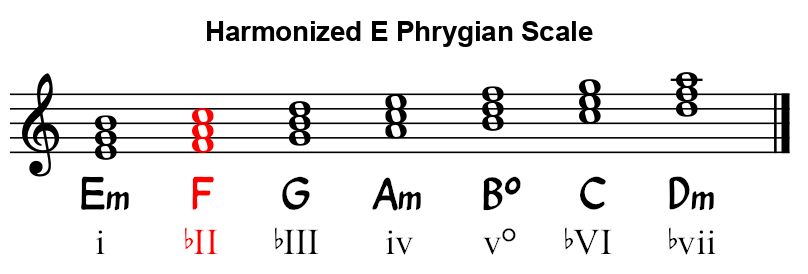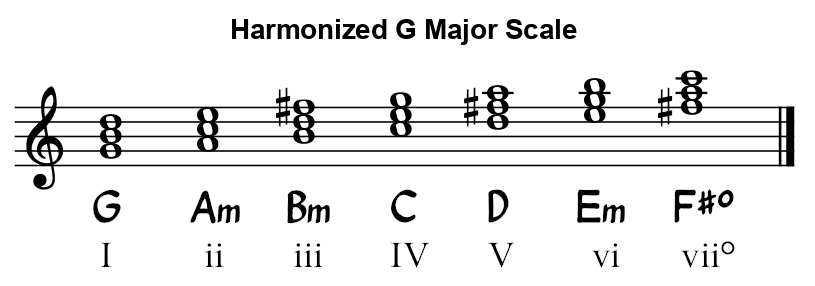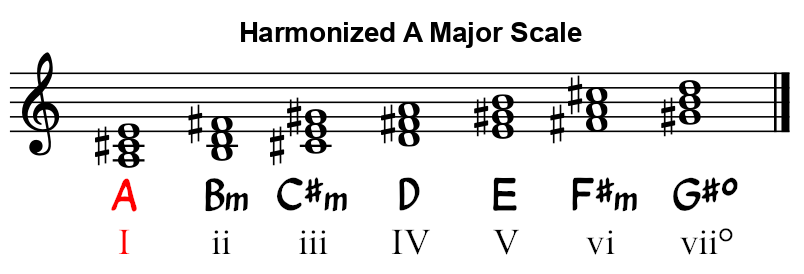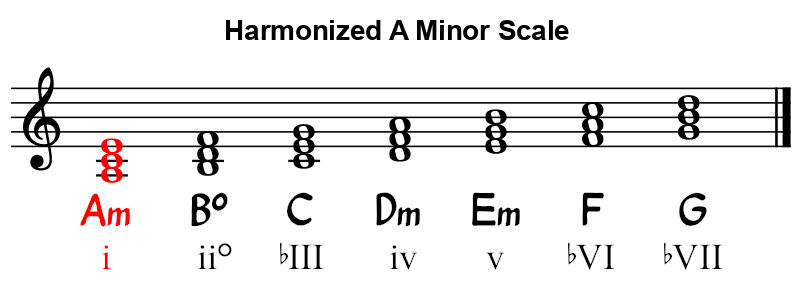To this point in the series, most of the key centers we have worked with have been based on the harmonized major or minor scales. But music can also be based on a harmonized modal scale or a combination of harmonized scales.
This post will cover modal harmony, some hybrid tonalities and a few common variations made to the harmonized major and minor scales.
Modal Harmony
A modal scale can be harmonized the same way a major or minor scale is harmonized.
All of the modal scales related to any given major scale will contain the exact same diatonic chords as that major scale, but in a different order and with different Roman numerals assigned to each of the chords.
For example, the chords diatonic to a harmonized C major scale are the same as the chords diatonic to a harmonized:
- D Dorian scale.
- E Phrygian scale.
- F Lydian scale.
- G Mixolydian scale.
- A Aeolian scale.
- B Locrian scale.
Fig.1


Modal Tonality
Music based on a harmonized modal scale is called modal tonality and music based on a specific harmonized modal scale would be characterized as being in that tonality.
For example, if a piece of music is based on an E Phrygian scale and primarily contains chords diatonic to that scale, the music would be characterized as being in an E Phrygian tonality.
The chord progression in fig.2 is in an E Phrygian tonality.
Fig.2

Modal Key Signatures
The modal keys don’t have their own key signatures. Just as a natural minor scale shares the same key signature as its relative major scale, each of the other modal scales shares the same key signature as its relative major scale.
For example, all of the modes derived from a C major scale (fig.1 above) share the same key signature as a C major scale: no sharps or flats.
If a piece of music has a key signature containing no sharps or flats but has a tonic note of E and/or a tonic chord of Em, that would indicate that the music is in an E Phrygian tonality.
Hybrid Tonalities and Common Minor Key Variations
The previous sections covered modal tonalities in theory. In practice, music is rarely based entirely on a harmonized modal scale, just as it is rarely based entirely on a harmonized harmonic minor or melodic minor scale.
Music is more commonly based on a harmonized major or minor scale with elements of a related scale’s harmony incorporated into it.
The incorporated elements from the other scale can be viewed as a variation on the standard major or minor harmony or the music can be viewed as being in a hybrid tonality – a combination of the harmonies of the two scales.
The Dorian Scale Variations
A piece of music in the key of E minor would primarily contain chords diatonic to an E minor scale (fig.3).
Fig.3

But in a minor key, the ii chord is usually played as minor (not diminished) and the IV chord is usually played as major (not minor).
These common variations are incorporated from a harmonized E Dorian scale (fig.4).
Fig.4

The chord progression in fig.5 is in the key of E minor. It incorporates the minor ii and major IV chords from a harmonized E Dorian scale.
Fig.5

So we could say that the chord progression is:
- In the key of E minor with some Dorian scale variations.
- In a hybrid key, a combination of the E minor and E Dorian scales.
The Harmonic Minor Scale Variation
In a minor key, the V chord is usually played as major or dominant seventh, not minor. This common variation is incorporated from a harmonized E harmonic minor scale (fig.6).
Fig.6

The chord progression in fig.7 is in the key of E minor. It incorporates the V chord from a harmonized E harmonic minor scale.
Fig.7

We could say that the chord progression is:
- In the key of E minor with a harmonic minor scale variation.
- In a hybrid key, a combination of the E minor and E harmonic minor scales.
The Phrygian Scale Variation
In a minor key the ii chord is usually played as minor, not diminished. But a bII chord could also be included in a minor key chord progression.
This variation is incorporated from a harmonized E Phrygian scale (fig.8).
Fig.8

The chord progression in fig.9 is in the key of E minor. It incorporates the bII chord from a harmonized E Phrygian scale.
Fig.9

We could say that the chord progression is:
- In the key of E minor with an E Phrygian scale variation.
- In a hybrid key, a combination of the E minor and E Phrygian scales.
The bV Chord
The chord built on a scale’s flatted fifth degree is not diatonic to a major or minor scale or any modal scale, but it is commonly incorporated into a minor key chord progression, usually in heavy metal music as a power chord.
For example, a chord progression in the key of E minor would incorporate a Bb5, the power chord built on the flatted fifth degree of an E minor scale.
The chord progression in fig.10 is in the key of E minor and incorporates a bV power chord.
Fig.10

The Major I Chord
The major I chord is obviously not diatonic to a minor scale, but it is sometimes substituted for the minor i chord in an otherwise minor key chord progression.
The chord progression in fig.11 is in the key of E minor and contains an E major I chord.
Fig.11

A Common Major Key Variation
The Mixolydian Scale Variation
As with minor keys, major keys have common variations as well. One of the most common is the Mixolydian scale variation.
A piece of music in the key of G major would primarily contain chords diatonic to a G major scale (fig.12).
Fig.12

But in a major key, the vii° chord’s root note is often lowered a half step and the bVII chord is played as major, not diminished.
This common variation is incorporated from a harmonized Mixolydian scale (fig.13).
Fig.13

The chord progression in fig.14 is in the key of G major. It incorporates the major bVII chord from a harmonized G Mixolydian scale.
Fig.14

We could say that the chord progression is:
- In the key of G major with a G Mixolydian scale variation.
- In a hybrid key, a combination of the G major and G Mixolydian scales.
Modal Interchange (Borrowed Chords in Parallel Tonalities)
Modal interchange is when music based on a major or minor scale incorporates (or borrows) chords diatonic to its parallel major or minor scale.
For example, music in the key of A major can incorporate chords diatonic to the key of A minor and vice versa.
Fig.15 shows harmonized A major and A minor scales.
Fig.15


Major Key Modal Interchange
The chord progression in fig.16 is in the key of A major but it incorporates chords from a harmonized A minor scale.
Fig.16

A quick analysis of the progression will identify the key center and the borrowed chords:
- A major is the tonic I chord in the key of A major.
- F major is the bVI chord, borrowed from the key of A minor.
- G major is the bVII chord, borrowed from the key of A minor.
- The authentic cadence in the key of A major (E7 – A) is played at the end of the progression.
Minor Key Modal Interchange
Parallel tonalities are usually based on a major key, with chords diatonic to its parallel minor key incorporated into the progression, as in the example above.
But sometimes a parallel tonality is based on a minor key, with chords diatonic to its parallel major key incorporated into the progression.
The chord progression in fig.17 is in the key of A minor but it incorporates chords from a harmonized A major scale.
Fig.17

A quick analysis of the progression will identify the key center and the borrowed chords:
- Am is the tonic i chord in the key of A minor.
- C#m is the iii chord, borrowed from the key of A major.
- Dm is the iv chord in the key of A minor.
- E is the V chord, borrowed from the key of A major.
- The authentic cadence in the key of A minor (E – Am) is played at the end of the progression.
Related Posts
Related posts include:
